Mario Day STEM — Bring Mario World to Life with Hands-on Science and Engineering Activities!
Try these clever STEM activities to connect hands-on science and engineering to the ever-popular world of Mario! Let's-a go!
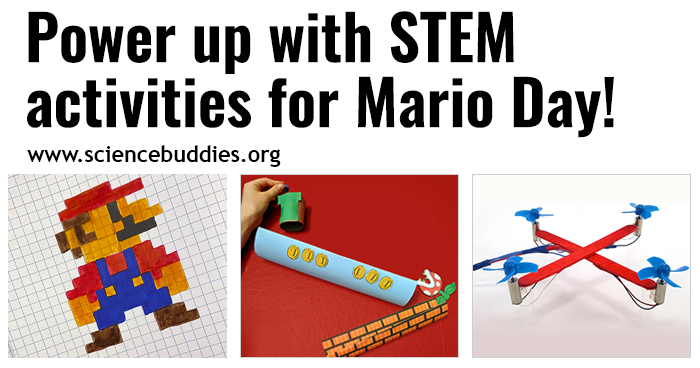
Your kids and students probably know Mario, Luigi, Princess Peach, Bowser, and the Mario World gang, and chances are you do, too!
March 10 is Mario Day, so known because in the right typeface, M A R 1 0 looks like M A R I O. (Once you see it, you see it!) This is the kind of clever correlation that pop culture loves. When you can tie in fun science and engineering activities, you've got the recipe for an epic win-win with students in the classroom or kids at home.
Level Up with Mario Basics
In the Super Mario games, Mario and his brother Luigi are plumbers in Mushroom Kingdom. Their mission is to rescue Princess Peach (aka Princess Toadstool) from Bowser, King of the Koopas. In the classic version, they journey through stages of the side-scrolling platformer game, kicking Koopa shells, hitting question (?) blocks, breaking brick blocks, picking up coins, dropping down tube-like warp pipes, trying to master difficult jumps, and questing for power-ups like Super Mushrooms, Fire Flowers, and 1-Up Mushrooms.
With his overalls, M-emblazoned red cap, and determined attitude, Mario is a super popular video game character (and game franchise). While there isn't a lot of "science" to pull out of the Mario gamescape, there are lots of hands-on STEM activities you can do with kids to tie into the Mario storyline. With these free activities, you and your students can use science and engineering to build your own version of Mario World.
(For a Super Mario Bros. refresher and some Mario history, just follow this warp-pipe tunnel down to the backstory (aka bottom of this post).
Boss Level Tip: Small toys or minifigures can be used with many of these activities to combine storytelling and imaginative play with STEM learning. If you don't already have a supply of minifigs, you might find that having small characters (like these or these) boosts the imaginative play value and engagement.
Science and Engineering Activities with a Mario Twist
1. Mario World Marble Run
 Classic Super Mario Bros. is a side-scroller game, but when he and Luigi jump into a warp pipe, they are transported to a new location. With the Build A Wall Marble Run activity, kids can build their own network of "tubes," "tunnels," and "warp pipes" to create a Mario World of their own—on the wall! Pro Tip! Be sure to add in some fun lightweight obstacles (like Koopas) for your marble run object to push through. Add in a few power-ups, too, for extra fun!
Classic Super Mario Bros. is a side-scroller game, but when he and Luigi jump into a warp pipe, they are transported to a new location. With the Build A Wall Marble Run activity, kids can build their own network of "tubes," "tunnels," and "warp pipes" to create a Mario World of their own—on the wall! Pro Tip! Be sure to add in some fun lightweight obstacles (like Koopas) for your marble run object to push through. Add in a few power-ups, too, for extra fun! 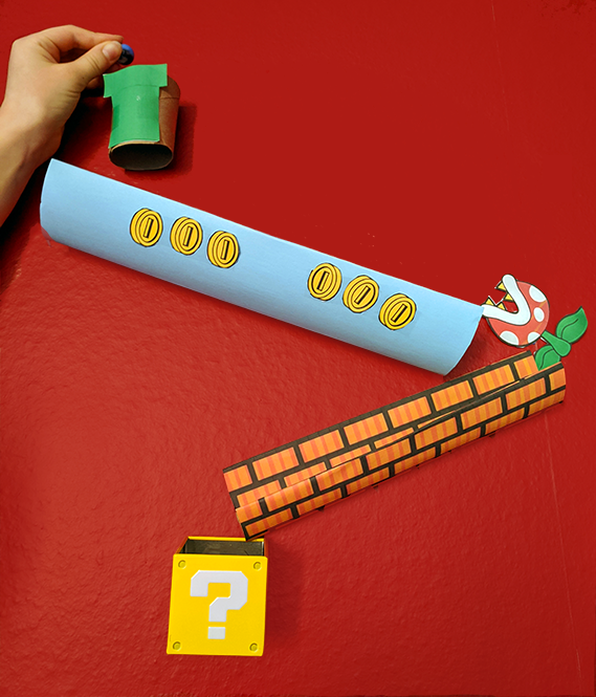
2. Wind Flower Air Blasts
 Mushroom Kingdom isn't all about mushrooms! There are numerous power-ups in Mario World. When Mario eats a Wind Flower, he can blow gusts of wind at enemies, and eating an Ice Flower lets Mario throw ice balls that freeze things. With the Build A Vortex Cannon! activity, kids can master the physics of wind gusts using balloons to build their own vortex cannons, no flower-eating required!
Mushroom Kingdom isn't all about mushrooms! There are numerous power-ups in Mario World. When Mario eats a Wind Flower, he can blow gusts of wind at enemies, and eating an Ice Flower lets Mario throw ice balls that freeze things. With the Build A Vortex Cannon! activity, kids can master the physics of wind gusts using balloons to build their own vortex cannons, no flower-eating required!
3. Propeller Mario Drone
 Although there is a popular quadcopter Mario toy, there isn't really a Drone Mario in Super Mario World. But there is a Propeller Mario! When Mario eats a Propeller Mushroom, he gets a propeller-head helmet, flight suit, and blue shoes! Using directions in the DIY Mini Drone activity, kids can build their own drones with colorful propellers, craft sticks, and a simple circuit. Tip! You'll need to set up a string or dowel to contain your drone's flight, but this is a drone that works great indoors!
Although there is a popular quadcopter Mario toy, there isn't really a Drone Mario in Super Mario World. But there is a Propeller Mario! When Mario eats a Propeller Mushroom, he gets a propeller-head helmet, flight suit, and blue shoes! Using directions in the DIY Mini Drone activity, kids can build their own drones with colorful propellers, craft sticks, and a simple circuit. Tip! You'll need to set up a string or dowel to contain your drone's flight, but this is a drone that works great indoors! Kit available! The DIY Mini Drone Kit contains the specialty items you need to build the basic mini drone.
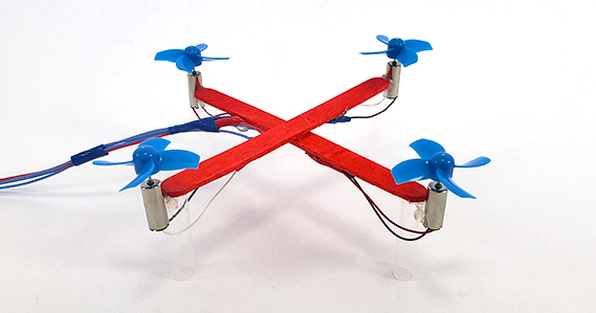
4. Cotton Ball Launcher
 Eat a Fire Flower, and Mario gains the ability to throw fireballs as he moves through Mario World. "Taste disgusting, but if I eat them, I can shoot Fireballs," says Mario. With a homemade cotton ball launcher, kids won't need to eat anything disgusting to shoot soft cotton balls and pretend they have Mario-like power-ups. Bonus! This simple launcher is made from a recycled cardboard tube. (See other great STEM activities that use cardboard tubes.)
Eat a Fire Flower, and Mario gains the ability to throw fireballs as he moves through Mario World. "Taste disgusting, but if I eat them, I can shoot Fireballs," says Mario. With a homemade cotton ball launcher, kids won't need to eat anything disgusting to shoot soft cotton balls and pretend they have Mario-like power-ups. Bonus! This simple launcher is made from a recycled cardboard tube. (See other great STEM activities that use cardboard tubes.) 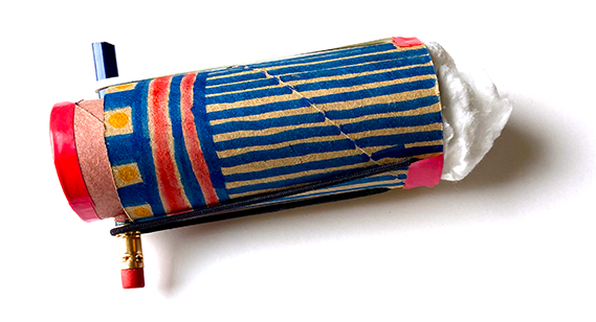
4. Cape Mario Parachute
 Once you get a cape feather in Super Mario, you can use Mario's cape to fly. Take a running start and jump (holding down the correct button, of course), to make Cape Mario take off. Using the cape requires some maneuvering with the controller to stay in the air, but this power-up gives Mario a new way to reach coins up high. When Cape Mario lands, the cape functions like a parachute and helps drop him safely to the ground. In the Make a Parachute activity, kids can experiment with cape-like parachutes to explore how forces like gravity and air resistance make them work. These forces are invisible, but you can see them in action when dropping toy figurines (with parachutes attached!) from high distances. Bonus tie-in! Mario Kart fans can connect parachute science with the parachute glider.
Once you get a cape feather in Super Mario, you can use Mario's cape to fly. Take a running start and jump (holding down the correct button, of course), to make Cape Mario take off. Using the cape requires some maneuvering with the controller to stay in the air, but this power-up gives Mario a new way to reach coins up high. When Cape Mario lands, the cape functions like a parachute and helps drop him safely to the ground. In the Make a Parachute activity, kids can experiment with cape-like parachutes to explore how forces like gravity and air resistance make them work. These forces are invisible, but you can see them in action when dropping toy figurines (with parachutes attached!) from high distances. Bonus tie-in! Mario Kart fans can connect parachute science with the parachute glider. 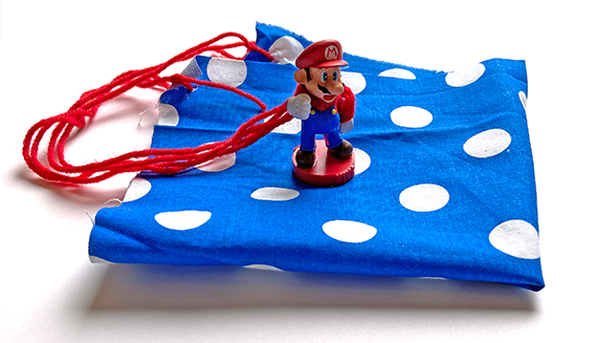
Note: for an educator lesson plan that explores forces using simple parachutes, see Skydive Into Forces. See also Forces and Laws of Motion Lessons.
6. 8-bit Mario
Computer graphics have come a long way since Mario first appeared in 8-bit form. The "look" of 8-bit images has remained popular thanks to contemporary games like Minecraft, which isn't 8-bit but features a pixelated, block-like image style. Mario is a good bit more detailed today than in the 80s, and most gamers are happy that advances in technology have brought much more detail to game images. 8-bit Mario characters are still fun for kids to draw. With graph paper and markers or crayons, kids can use the Seeing Science: Why do Video Game Characters Look Better Today? activity to see how the number of pixels relates to the amount of detail you see in a character. (Power-up! Interested students can also do a version of this exploration as a science fair project.)
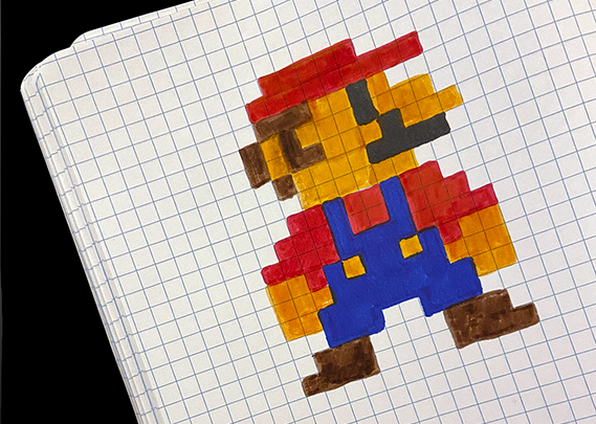
7. Catapult Launcher
 In Super Mario Galaxy, jumping on a Launch Star is a way to transport Mario to another planet or world. We think a popsicle stick catapult is a great way to bring the Launch Star sensation to your home Mario World. Kids can envision their Mario jumping onto the catapult's base (the lid) and then being catapulted to another location. Challenge kids to experiment with launching to be able to accurately launch Mario to another part of your homemade Mario World! Launching mini Koopas? We can see that happening, too! (Tip! They might want to build in a soft landing area.)
In Super Mario Galaxy, jumping on a Launch Star is a way to transport Mario to another planet or world. We think a popsicle stick catapult is a great way to bring the Launch Star sensation to your home Mario World. Kids can envision their Mario jumping onto the catapult's base (the lid) and then being catapulted to another location. Challenge kids to experiment with launching to be able to accurately launch Mario to another part of your homemade Mario World! Launching mini Koopas? We can see that happening, too! (Tip! They might want to build in a soft landing area.)
8. Wind-powered Kart
 In Mario Kart, there are a bunch of different gliders you can use, depending on the kart. If you look at the lineup of gliders from a STEM perspective, you might notice that the different shapes and designs would probably play a significant role in how well they work! In the game, the physics of the glider may not matter, but for a fun STEM tie-in, kids can experiment with wind-powered cars to explore how different design features would change the speed and functionality of a glider in the real world.
In Mario Kart, there are a bunch of different gliders you can use, depending on the kart. If you look at the lineup of gliders from a STEM perspective, you might notice that the different shapes and designs would probably play a significant role in how well they work! In the game, the physics of the glider may not matter, but for a fun STEM tie-in, kids can experiment with wind-powered cars to explore how different design features would change the speed and functionality of a glider in the real world.
9. Walking Mario
 Mario doesn't appear to be very tall, even in relation to other characters in Mushroom Kingdom. While height doesn't matter in terms of how much ground he covers as he runs and jumps through Mario World, in real life, height and stride go together! With the Stepping Science: Estimating Somebody’s Height from Their Walk get-moving STEM activity, kids can experiment to correlate stride length with height. How might the difference in someone's height change how much time it takes to walk a certain distance? (Bonus! You can find lots of speculation online for exactly how tall Mario and other characters are!)
Mario doesn't appear to be very tall, even in relation to other characters in Mushroom Kingdom. While height doesn't matter in terms of how much ground he covers as he runs and jumps through Mario World, in real life, height and stride go together! With the Stepping Science: Estimating Somebody’s Height from Their Walk get-moving STEM activity, kids can experiment to correlate stride length with height. How might the difference in someone's height change how much time it takes to walk a certain distance? (Bonus! You can find lots of speculation online for exactly how tall Mario and other characters are!) 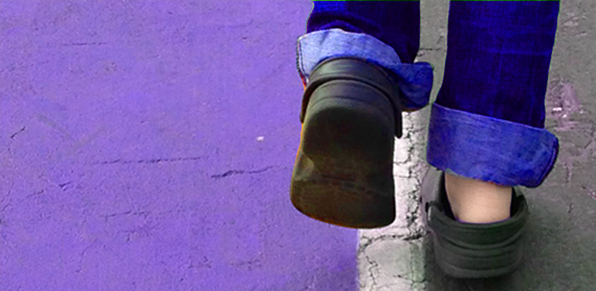
10. A Mario-inspired Rube Goldberg Machine
 With the pipe- and tunnel-like network central to many Mario World stories, it is easy to think about taking things a step further with a clever Rube Goldberg machine. For a real challenge, challenge kids to start with a wall marble run (see above) and have that connect as part of a DIY Rube Goldberg machine's chain of events. What will the final "task" be that the machine accomplishes?
With the pipe- and tunnel-like network central to many Mario World stories, it is easy to think about taking things a step further with a clever Rube Goldberg machine. For a real challenge, challenge kids to start with a wall marble run (see above) and have that connect as part of a DIY Rube Goldberg machine's chain of events. What will the final "task" be that the machine accomplishes?
11. Camouflage Koopas
 With their turtle-like shells, the Koopas show up in a range of colors (green, blue, yellow, red, etc.), and there are several Koopa subtypes in the different games, like Koopeleons, which can briefly turn invisible. What if the colors of Koopas were related to how easy or difficult they were to defeat? What if their colors allowed them to blend into the environment differently? Would they be easier for Mario to overlook as he runs through a level? What would a chameleon power-up do? It isn't hard to think about Koopa colors in terms of the way animal species adapt and the ways in which some animals use camouflage as a survival technique! The simple Candy Camouflage activity uses colorful candies to let kids explore, firsthand, how camouflage works. For a similar activity with colored toothpicks, see Can You Hide in Plain Sight?.
With their turtle-like shells, the Koopas show up in a range of colors (green, blue, yellow, red, etc.), and there are several Koopa subtypes in the different games, like Koopeleons, which can briefly turn invisible. What if the colors of Koopas were related to how easy or difficult they were to defeat? What if their colors allowed them to blend into the environment differently? Would they be easier for Mario to overlook as he runs through a level? What would a chameleon power-up do? It isn't hard to think about Koopa colors in terms of the way animal species adapt and the ways in which some animals use camouflage as a survival technique! The simple Candy Camouflage activity uses colorful candies to let kids explore, firsthand, how camouflage works. For a similar activity with colored toothpicks, see Can You Hide in Plain Sight?. 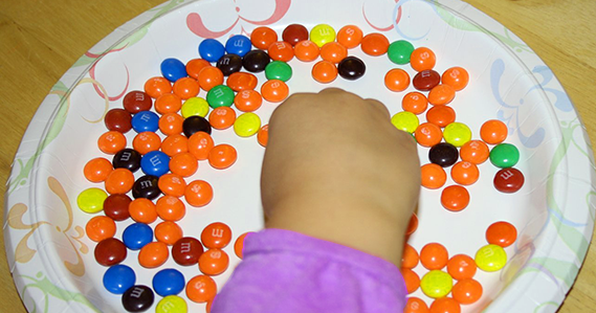
12. Shadow Puppet Mario
 Shadow Mario is an evil Mario doppelgänger. He looks like Mario, but he's translucent, all blue, carries a Magic Paintbrush, and is out to steal Princess Peach! Using the science of light and shadow, kids can set up a Mario World scene for Mario to run through and then have lots of fun putting on a show. Homemade shadow puppets made from paper and craft sticks are a great way to turn Mario play into a creative STEM adventure! The Making Shadow Puppets activity has directions for making and using DIY shadow puppets.
Shadow Mario is an evil Mario doppelgänger. He looks like Mario, but he's translucent, all blue, carries a Magic Paintbrush, and is out to steal Princess Peach! Using the science of light and shadow, kids can set up a Mario World scene for Mario to run through and then have lots of fun putting on a show. Homemade shadow puppets made from paper and craft sticks are a great way to turn Mario play into a creative STEM adventure! The Making Shadow Puppets activity has directions for making and using DIY shadow puppets. 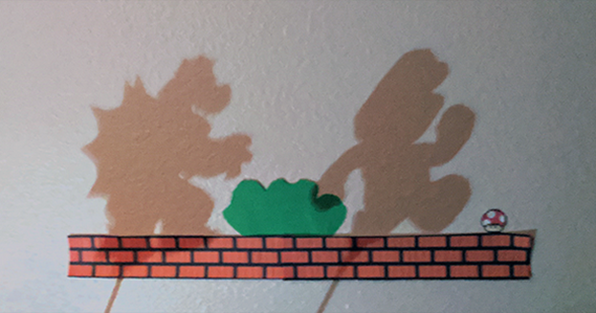
13. Bumper Karts
 Mario Kart features all kinds of different "kart" models, including ways you can customize your kart with different wheels or gliders. Specs for your kart include speed, acceleration, weight, handling, and traction. In the game, durability isn't a key concern, but in the real world, designing cars that can withstand crashes is important! The Engineering Car Crash Safety with Newton's Third Law lesson is a great way to have kids use engineering design to think about ways to make cars better able to withstand crashes. A good bumper system is a power-up every cart or kart can use!
Mario Kart features all kinds of different "kart" models, including ways you can customize your kart with different wheels or gliders. Specs for your kart include speed, acceleration, weight, handling, and traction. In the game, durability isn't a key concern, but in the real world, designing cars that can withstand crashes is important! The Engineering Car Crash Safety with Newton's Third Law lesson is a great way to have kids use engineering design to think about ways to make cars better able to withstand crashes. A good bumper system is a power-up every cart or kart can use! 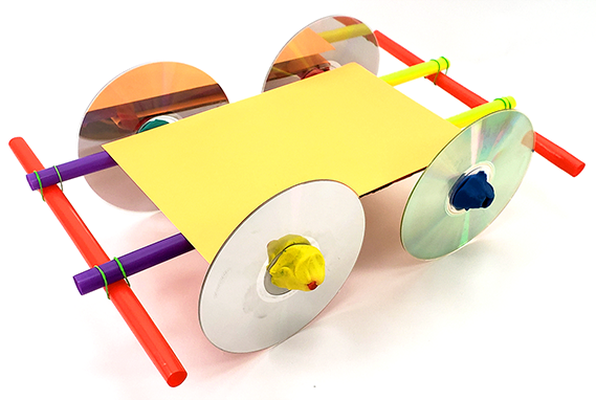
14. Designing Video Games
Kids interested in game design and computer coding can explore game creation science with projects like Want to Make a Video Game? Here's How! and Power Play: How Does Animation Timing Affect Your Perception of Game Action? and others included in the 25+ Coding Projects for Beginners and Beyond collection.
Mario History
Mario Bros. first debuted in 1983 as an arcade game. Super Mario Bros. followed in 1985 as the first in a series of Super Mario platformer titles for Nintendo Entertainment System (NES). Super Mario Bros 2 followed in 1988 and then Super Mario Land in 1989. With more than a dozen title releases after that, Mario, the video game plumber on a quest to save Princess Peach from Bowser, is a classic in the world of Nintendo gaming.
Tip: The 1983 debut wasn't Mario's first game appearance. If your gaming knowledge goes far enough back to the 1981 Donkey Kong arcade game, you might remember that Mario was the character trying to rescue his girlfriend.
2020 marked the 35th anniversary of Super Mario, and the Mario series continues to attract gamers of all ages. The most recent Mario releases include: Super Mario 3D All-Stars (Nintendo Switch), New Super Mario Bros. U Deluxe (Nintendo Switch), and Super Mario Maker 2 (Nintendo Switch), a game that enables players to create their own maps to rebuild Princess Peach's castle.
Level-up Tip: For other clever "day" tie-ins, don't miss Pi Day (on 3.14) and Star Wars Day (aka May the 4th be with You) on May 4.
See also, Imagine Your Story - STEM Activities for Storytellers of All Ages!.
Categories:
You Might Also Enjoy These Related Posts:
- 25+ Earth Day Science Experiments and Activities
- 6 Picks for St. Patrick's Day STEM
- Mario Day STEM — Bring Mario World to Life with Hands-on Science and Engineering Activities!
- 12 Valentine's Day STEM Activities
- STEM Calendar for Educators: Month by Month STEM Projects
- Make Some New Year's Noise with Science Projects!
- Holiday STEM Projects to Make and Give
- Gingerbread STEM!



















